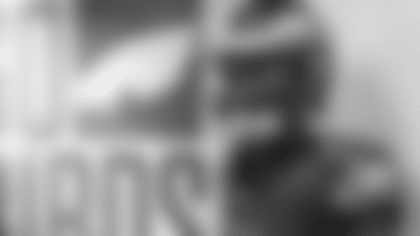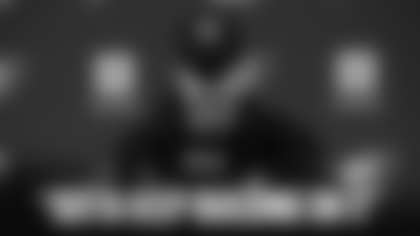Chosen by Pittsburgh in the 1970 NFL Draft, rather than traveling to the Steel City, Wake Forest guard Ed George headed north to Montreal and signed with the Alouettes of the Canadian Football League.
And over three seasons as a guard and two as a tackle, he was named All-CFL four times. In 1974, he was named as the league's Outstanding Offensive Lineman.
Clearly a standout on the field, it's what George did at the negotiating table, which ultimately led him to the NFL in 1975 and the then-Baltimore Colts.
"I was the player representative for the club with the Players Association. And we, politely put, had ramrodded a strike through and negotiated better benefits for the players," George says. "And I think what happened was, that didn't endear me to management. Despite my success up there, I think they wanted me out of that league."
George didn't find the grass greener in Baltimore.
"I think they just wanted people. I never understood any part of it and I didn't like it five minutes after I was there," George says. "I got the impression that no matter what I did, I wasn't going to play. And yet when I played, I think I started in four or five games, and I got the game ball three or four times. What sense did that make?
"When the season was over, I told them, 'I need to get out of here. I'm a workaholic type of guy. I'm not going to do this and not participate. Especially if I think I'm capable of playing.' So they traded me to Philadelphia.
"I couldn't figure why Philadelphia would pick me up because they gave a high draft choice to get me. And I didn't realize what was going on until I got there and looked over on the practice field and there was the linebackers coach, Rod Rust, who was the defensive line coach for the Alouettes when I was there. So he saw me all those years I played there and knew what I was capable of doing."
The 1976 season was George's first with the Eagles. It was Head Coach Dick Vermeil's first season with the Birds, as well. The two made quick impressions on each other.
"Our first team meeting with Dick Vermeil, we're all in there and Dick says, 'I want to show you something to give you an understanding,'" George says. "And he put a film up of the previous season. Back then, guys used to do these little dances in the end zone and spin the ball like it's dice. Vermeil made a statement, dead-coldblooded. 'You see this? This will never happen again. If it happens, the guys involved in the circle will be gone.' You could have dropped a dime on the floor and heard it. That room was as quiet as it could get. I think that kind of set a tempo.
"The first day of practice, Vermeil comes over to me and says, 'We've got some one-on-one stuff to find out whether you can play or not.' They don't use a football in those drills; it's a physicality event. And when that was over with, Vermeil comes over to me and says, 'I want you to line up at right tackle.' Well, they had Jerry Sisemore there, who was their No. 1 pick in the draft the year before. A great guy and a great football player. I didn't know what that's about, but they moved Jerry to guard and put me at tackle."
With George at right tackle, Sisemore at right guard, Guy Morriss at center, Wade Key at left guard, and Stan Walters at left tackle – Philadelphia's offensive line was nothing if not solid.
"I think we basically had respect for each other," George says. "I mean, there was no doubt in my mind that there was a close camaraderie there. They were all good, solid players. They could all play for basically anybody if they wanted to give them a chance. And there was not a one on the team that I didn't like and not have respect for."
Spending three seasons with the Eagles before making his way back to the CFL in 1979 to play for the Hamilton Tiger-Cats, what are among George's fondest memories from his time in Philadelphia?
"I was very close to Wade Key and Guy Morriss, and just having that camaraderie and the idea that I could play there. They let me play the way I functioned, so to speak. And I thought the world of Dick Vermeil," George says.
"I'll give you an example. We played a game once where a referee walked over to me before the game and told me, 'You need to keep your hands inside.' And I'm going, 'What are you talking about? This is a football game. Why are you threatening me out here and trying to intimidate me before a football game?' Vermeil went ballistic when he saw that because that referee had no business doing that. 'If you see him do something wrong, just tell us. That's your job. Go about your business.'
"But I think it was the camaraderie. And Vermeil created that. I think his coaching staff did the same thing. I thought he had an immense camaraderie on that team."
Following football, George, who was enshrined into the CFL Hall of Fame in 2005, went into the investment business. In pension development, he initially worked for the consulting firms AG Becker and Mercer Consulting.
"And then one of the firms that I was grading and monitoring was a firm called Manning & Napier," George says. "They had one of the best results I'd ever seen from an investment money manager. And lo and behold, shortly after I was in the business, they came after me.
"I was with them for about 15 years, and when I left (as the executive vice president), I was the second-biggest stockholder in the company. And we were about $10 billion at the time; they're about $20 billion now. They were No. 1 in the country last year in their class. I sat on their board for three or four years and retired."
Retired but not close to being tired, George and his wife, Rose Marie, make their home in Scottsville, Virginia. They have two children and three grandchildren.
"I'll be 75 years old in August, and I'm still working out seven days a week, twice a day," George says. "And I've got a resting heart rate in the 50s."























